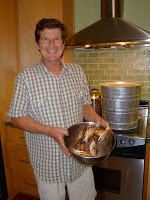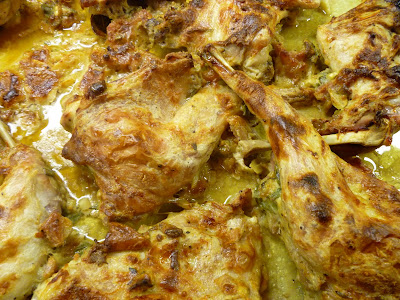I remember him sitting in the driver’s seat of the Buick Station Wagon as its big V8 engine idled, a cigarette dangling from his fingertips. As my brother and I crept forward in the darkness and looked back at him for reassurance we could see only the Salem’s embers glowing as he inhaled.
“Hurry up!” he’d hiss. And onward we’d scurry, hearts pounding, palms sweaty.
We’d hurl the heavy garbage bags of bloody entrails into the neighborhood park’s dumpsters, turn on our heels and run back to the safety of his car. It seemed like miles of ground to cross between the dumpster and the Buick. I was scared to death and sure that the cold firm hand of a policeman would clutch the back of my collar before I could throw myself into the back seat and lock the car door.
The dirty deed done and The Law averted, my Dad would peel out and race for home, quickly finishing the rest of his secret smoke before rejoining polite society.
“How’d it go?” my sweet mother would ask as she greeted us at the door. I couldn’t help but feel deep shame that all of us, even my gentle mom, were a part of this dark family secret. We’d been doing it for years and I knew it was wrong. But there was no stopping my dad, who insisted his kids come along for the ride each time, miniature henchmen to do his bidding.
My dad loved to fish for albacore and my mother liked clean trash cans.
Forty years ago the annual albacore runs offshore in San Diego were bountiful and my dad and his buddies would come home from overnight charter trips with dozens of big tuna. They’d divide up the catch and we kids would watch my dad skillfully clean his share as the coals in his Weber turned grey.
Dinner over, an impassioned conversation would invariably ensue between my mother and my father about how many days it would be until Trash Day. And invariably, if it was further into the future than the next morning, my mother would demand a midnight run to the park so that her trash cans wouldn’t be sullied by fishy odor.
Once their little juvenile delinquents had stealthily deposited the smelly fish guts into the Kate Sessions Park dumpsters, domestic bliss would be restored in our home.
I recalled these furtive outings as I stood over my kitchen sink the other night cleaning Dungeness Crabs. As I dropped the gills and shells and goopy viscera into a plastic garbage bag, I couldn’t help but silently calculate how many days until Trash Day. I didn’t make a nocturnal run to the nearest public dumpster but I did avoid lifting the lid of our outdoor bin for the remainder of the week.

It’s crab season right now and our local fishmonger was advertising strong supply and low prices--$4.95 per pound for live ones. So, Kathy and I cooked up a batch last weekend and served them with our favorite dipping sauce, a rich, spicy-sweet chile butter.

There’s no excuse for buying the crabs already cooked. It’s the easiest thing in the world to boil up a batch. I cleaned all eight in under 10 minutes, ripping off the legs and claws while Kathy, at the other end of our two person assembly line, partially cracked each piece and tossed the parts into a big serving bowl.
The crab was still warm when we served, accompanied by Caesar Salad and a couple of homemade baguettes.
Dungeness Crabs with Chile Butter
We usually buy one crab (1.5 to 2 pounds each) per person. Keep them on ice in an ice chest until you are ready to cook. Don’t keep them in a plastic bag—they don’t breathe much when they are on ice but they do need some air! The chile butter is divine. You’ll never go back to simple melted butter.
Bring a large pot (or pots depending on how many crabs you are cooking) of well salted water to a rolling boil.

Banish any squeamish dinner guests from the kitchen and drop the live crabs into the boiling water. Cover pot with lid and boil for 20 minutes. Crabs will turn deep orange when they are done.

After 20 minutes, dump the crabs into the sink and clean them as soon as they are cool enough to handle. There are ample directions on how to clean crabs on the internet. Here’s a quick recap from the Oregon Dungeness Crab Commission.
http://www.oregondungeness.org/cleaning.shtml
To serve, break off the legs and claws, give them each a quick crack with a crab cracker or nutcracker and toss them in a big serving bowl. Break each crab body in half and add to the bowl. Serve family style with a crab cracker and pick for each person.


Chile Butter
Each pair of dinner guests can share a ramekin of chile butter. This recipe makes plenty for about 8 crabs.
Melt three sticks of unsalted butter over low heat in a small saucepan. Spoon off the solids that rise to the top and discard.
Add:
2 Tbsp. ancho chile powder
4 tsp. brown sugar
2 tsp. kosher salt
1 ½ tsp. ground cumin
1 tsp. dried oregano
½ tsp. cayenne
The chile butter can be made a couple hours ahead and reheated gently. Right before serving, divide the melted butter into 4 -5 little ramekins, ensuring that the ground spices are evenly divided among them.
Dip each succulent bite of crab into the butter, stirring up some of the spice. Eat. Enjoy. Bibs optional.











































